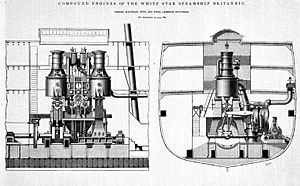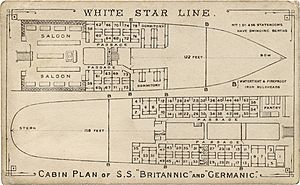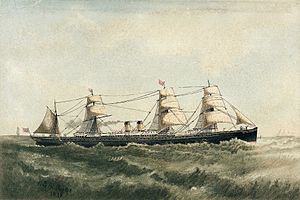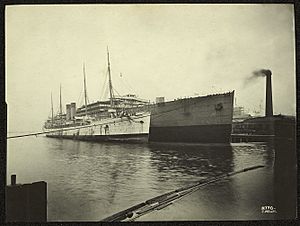SS Britannic (1874) facts for kids
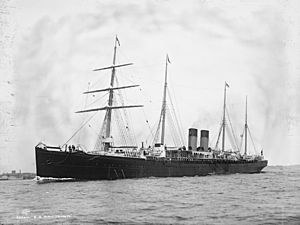
SS Britannic
|
|
Quick facts for kids History |
|
|---|---|
| Name | Britannic |
| Owner | White Star Line |
| Port of registry | |
| Route | Liverpool to New York standard route. |
| Builder | Harland & Wolff, Belfast |
| Yard number | 83 |
| Launched | 3 February 1874 |
| Completed | 6 June 1874 |
| Maiden voyage | 25 June 1874 |
| Honors and awards |
Blue Riband winner |
| Fate | Scrapped in 1903 |
| General characteristics | |
| Type | Steamship |
| Tonnage | 5,004 GRT |
| Length | 468 ft (142.65 m) |
| Depth | 45 ft (13.72 m) |
| Installed power | Steam |
| Propulsion | Single screw propeller |
| Sail plan | 4 masts, full-rigged ship |
| Speed | 16 knots (30 km/h; 18 mph) |
| Capacity | 220 Saloon- 1500 Steerage |
| Crew | 150 |
The SS Britannic was a famous ocean liner owned by the White Star Line. It was the first of three ships from this company to be named Britannic.
The Britannic was a steamship with a single propeller and also had sails. It was built for the White Star Line to travel across the North Atlantic Ocean. Its first name was going to be Hellenic, but it was changed to Britannic just before it was launched. The Britannic and its sister ship, the Germanic, sailed for almost 30 years. They mostly carried people moving to a new country on the busy route from Liverpool to New York City. In 1876, the Britannic won the Blue Riband award for being the fastest ship in both directions, averaging almost 16 knots (30 km/h).
Building the Britannic
Like most White Star Line ships, the Britannic was built at Harland & Wolff in Belfast, Ireland. It cost about £200,000 to build. The Britannic was the first White Star ship to have two tall funnels (smokestacks).
Power and Speed
The ship used steam power but also had sails, which was common for ships back then. It had four masts and was rigged like a barque. Two large steam engines powered the ship, making 4,970 horsepower. These engines pushed the ship's single propeller, allowing it to reach a top speed of 16 knots (30 km/h; 18 mph). The engines were made by Maudslay, Sons & Field, as Harland & Wolff were not yet experts in building steam engines.
Strong Design
The Britannic's hull (the main body of the ship) was divided into eight watertight compartments by nine strong walls called bulkheads. This design helped keep the ship safe if one section got damaged.
Experimental Propeller
The Britannic first had a special system that let its single propeller be moved up or down. This was supposed to help in rough seas, where the propeller might lift out of the water. It also allowed the ship to travel in shallow water by raising the propeller. However, this system caused a lot of shaking and needed too much repair. It also made the Britannic slower than its sister ship, the Germanic.
In 1875, after only nine trips, the Britannic was taken out of service. It was refitted with a normal propeller system, just like the Germanic. After this change, the Britannic's performance improved, and it was able to compete for the Blue Riband award.
Life Onboard
The Britannic and Germanic were designed to carry 1,720 passengers in total. There were two main types of tickets:
- 220 Saloon Class Passengers (this was like First Class)
- 1,500 Steerage Passengers
Saloon Class Comforts
Saloon Class areas were in the middle of the ship and were very fancy. They included a dining room, a special room for ladies, private rooms, smoking rooms, a library, and a barber shop. These cabins usually had two or four beds.
Steerage Passenger Areas
Steerage passengers stayed on the lower two decks. Their cabins were large, open rooms with beds around the edges. There was an open space in the middle for people to gather. The steerage areas were better than on many other ships of that time. They had good lighting, fresh air, and heating. The Britannic had a new ventilation system with a large steam-powered fan. This fan could send warm or cool air to every part of the ship.
Britannic's Journeys
The Britannic was launched on February 3, 1874. Its first trip was on June 25, 1874, from Liverpool to New York.
Early Adventures
On March 8, 1876, a small fire started in one of the ship's front storage areas while it was being repaired in Belfast. The fire was put out quickly, and the ship was only slightly damaged. After its propeller system was fixed, the Britannic became very fast. In November 1876, it won the westbound Blue Riband, traveling at 15.44 knots. A month later, it set the eastbound record at 15.95 knots. This made it the only White Star ship to hold both records at the same time. Its sister ship, the Germanic, took the westbound record in April 1877. The Guion Line's Arizona took the eastbound record in July 1879.
Collisions and Groundings
The Britannic's first four years were calm. But on October 26, 1878, it accidentally hit and sank a tugboat called Willie in Wapping, England. The tug's crew were all saved. On March 31, 1881, it collided with and sank the schooner Julia near Belfast. Again, all the crew were rescued, and the Britannic was not damaged.
Later that year, on July 4, 1881, the Britannic got stuck in fog off Kilmore, Ireland. It was on its way to Liverpool and stayed stuck for several days. Passengers safely left the ship in lifeboats. The ship seemed fine at first, but then water started leaking into its engine room. Experts came to help, pumping out water and unloading cargo to make the ship lighter. On July 8, it was refloated. The Britannic started being towed to Liverpool but leaked again and had to be beached (pulled onto the shore) in Wexford Bay. After more repairs, it finally reached Liverpool on July 14. The damage was minor, and the ship was back in service on July 18.
In 1883, Bram Stoker, the author famous for Dracula, is thought to have sailed on the Britannic. On January 13, 1887, the Britannic had a small collision with the steamship St. Fillans in the River Mersey. Both ships had only minor damage.
The Celtic Collision
On May 19, 1887, around 5:25 PM, the White Star liner SS Celtic crashed into the Britannic. This happened in thick fog about 350 miles (560 km) east of Sandy Hook, New Jersey. The Celtic was heading to New York with 870 passengers. The Britannic was on its second day of a trip to Liverpool with 450 passengers.
The two ships hit each other almost at a right angle. The Celtic's front part went 10 feet (3 m) into the back left side of the Britannic. The Celtic bounced off and hit two more times before sliding past. Six steerage passengers on the Britannic died right away, and six more were missing, likely washed overboard. No one died on the Celtic.
Both ships were badly damaged, but the Britannic had a large hole below its waterline. People on board panicked, thinking the ship would sink, and rushed to the lifeboats. The Britannic's captain, Hugh Hamilton Perry, used a pistol to help calm everyone down. Lifeboats were filled with women and children, though some men forced their way on. After the lifeboats launched, it became clear the Britannic would stay afloat. Lifeboats that were close by were called back. The others went to the Celtic. The two ships stayed together all night. The next morning, other ships arrived to help, and they all slowly made their way to New York Harbor. The Britannic was repaired in New York and was out of service for almost a month.
A Famous Passenger
Two-and-a-half-year-old Eleanor Roosevelt, who later became a very important First Lady of the United States, was on the Britannic during the collision. She was with her parents. Eleanor was put into a lifeboat, screaming and upset. She and her parents were taken to the Celtic and then back to New York. Eleanor was very scared to get back on a ship to continue their trip to Europe. Her parents went to Europe without her, leaving her with an aunt. Because of this event, Eleanor had a lifelong fear of water and ships.
Investigation Findings
An investigation in New York in June 1887 found that both captains were at fault for not following safety rules. The Celtics captain was criticized for not slowing down in fog. The Britannics captain was criticized for not sounding the ship's whistle before the crash. A big recommendation from this event was to extend separate shipping lanes across the entire Atlantic Ocean.
Later Years
On January 2, 1890, the Britannic collided with a British ship called Czarowitz in the Crosby Channel. The Czarowitz sank.
In August 1891, when the Britannic was 17 years old, it made its fastest trip ever from New York to Queenstown, taking 7 days, 6 hours, and 52 minutes.
Military Service
The Britannic made its last regular trip for White Star in August 1899. After this, the Royal Navy took over the ship to use it as a troopship. It transported soldiers to South Africa for the Second Boer War. During this time, the Britannic carried 37,000 troops over three years. In November 1900, the Britannic sailed to Australia with a special group to represent Great Britain at the start of the Australian Commonwealth. It took part in a fleet review in Sydney Harbour. On the way back, it got stuck in the Suez Canal but was refloated.
End of the Journey
After the war ended in October 1902, the Britannic was returned to White Star Line. They sent it to its builders in Belfast to see if it could be updated. There was a plan to give the Britannic more modern engines and new interiors. However, in 1903, the builders decided that it would cost too much money to update the 29-year-old ship. So, the Britannic was sold for scrap for £11,500. On August 11, 1903, it was towed from Belfast to Hamburg, Germany, where it was taken apart.
See also
- SS Germanic (1874) - sister ship
- HMHS Britannic
- MV Britannic (1929)


